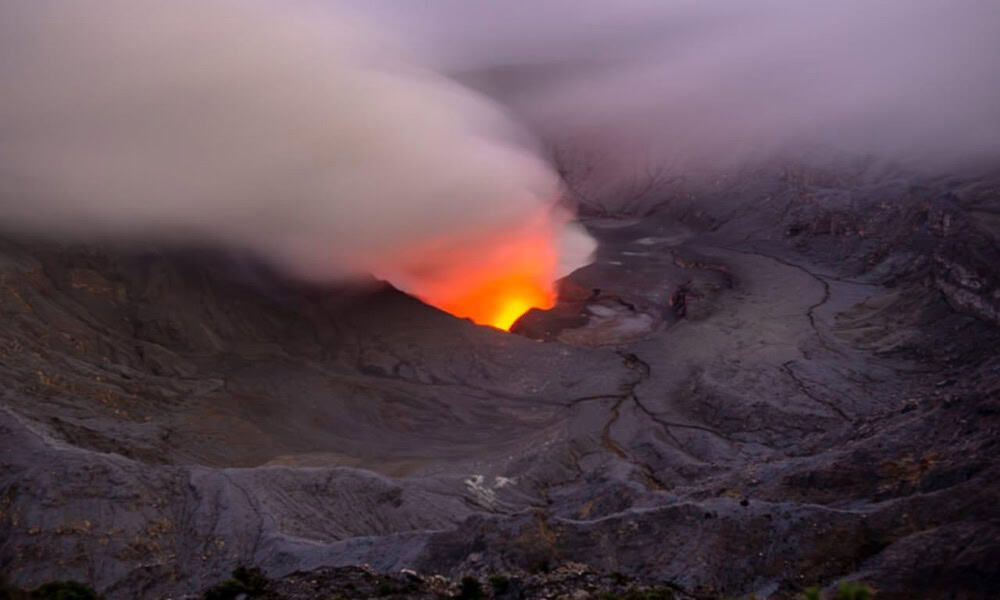Costa Rica’s Poás Volcano has been putting on a fiery show, with its crater glowing red from burning sulfur and molten rocks. Scientists from the Volcanological and Seismological Observatory of Costa Rica (OVSICORI-UNA) and the University of Costa Rica (UCR) have been tracking this incandescence—visible light from rocks heated above 500°C—since late April. Recent reports confirm temperatures in the crater hit 700°C, signaling intense volcanic activity. Here’s the latest on what’s happening, what it means, and how local authorities are responding.
A Red Glow Lights Up the Crater
The red glow, first captured by OVSICORI’s webcams on April 22, comes from sulfur combusting at temperatures around 250°C and rocks heated to extreme levels. Researchers from UCR, using satellite images from the Sentinel satellite’s infrared band, confirmed a hot spot in the crater on May 4, with temperatures exceeding 700°C.
This incandescence, visible at night, is a sign of ongoing eruptions, though the volcano’s activity has stabilized slightly in recent weeks. Volcanologist Geoffroy Avard from OVSICORI notes that while the glow is striking, it’s part of Poás’ normal eruptive behavior, driven by its acidic crater lake, Laguna Caliente.
The intense heat and gas emissions, including sulfur dioxide at 600–5,000 tons per day, have raised concerns about air quality. Communities like Grecia, Sarchí, and Alajuela have faced ashfall and toxic air, prompting health warnings to wear N95 masks and stay indoors during peak emissions.
Alert Levels Adjust
On June 2, the National Emergency Commission (CNE) updated alert levels for Poás Volcano and surrounding areas, reflecting a slight drop in activity. Seismic activity, ash emissions, gas flow, and infrasound have stabilized, leading to these changes:
| Area | Alert Level | Notes |
|---|---|---|
| Poás Volcano National Park | Orange | Park remains closed; high risk of eruptions. |
| Toro Amarillo (Sarchí) | Orange | Ongoing ashfall and gas risks. |
| Sarchí, Grecia | Yellow | Monitor air quality; wear masks if needed. |
| Alajuela, Naranjo, Poás, Río Cuarto, Sarapiquí | Green | Low immediate risk but stay vigilant. |
Despite the downgrade, the CNE warns that Poás remains active, and conditions could shift quickly. The volcano has been erupting since January, with ash plumes reaching up to 4,500 meters in April. Heavy rains also pose a lahar risk—mudflows of ash and water—along rivers like Desagüe, Anonos, Gorrión, and Agrio.
Park Closures and Warnings
Poás Volcano National Park, a major tourist draw with 200,000 visitors annually, has been closed since April 23 under a red alert, now lowered to orange. The CNE and OVSICORI urge people to avoid the crater and restricted zones due to dangers like toxic gases, falling rocks, and sudden eruptions. The U.S. Embassy in Costa Rica has echoed these warnings, advising travelers to check local news and steer clear of high-risk areas.
Local businesses in Poás, Poasito, and nearby towns have taken a hit, with tourism income dropping 40–67% since the park’s closure. Authorities are promoting alternative attractions, but recovery depends on the volcano stabilizing further.
Why This Matters
Poás’ activity is a reminder of our country’s volcanic landscape. While the incandescence is a natural spectacle, it signals real risks: poor air quality, potential lahars, and economic impacts on tourism-dependent communities. For residents and visitors, staying informed is key. Check updates from OVSICORI, the CNE, or local news, and follow safety guidelines like avoiding restricted areas and wearing masks during ashfall.
The volcano’s behavior is unpredictable, but scientists are keeping a close eye on it. For now, Poás continues to glow, erupt, and shape life in Costa Rica’s Central Valley. Stay safe and keep an eye on official channels for the latest.






